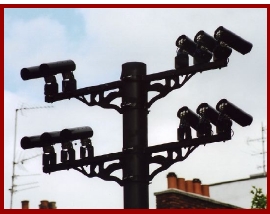| ||||||||||||||||||||||||||||
 | ||||||||||||||||||||||||||||
Welcome to the | ||||||||||||||||||||||||||||
 | ||||||||||||||||||||||||||||
CCTV Camera Performance - Sensitivity Another figure often quoted on the camera specification sheet is the S/N, or Signal to Noise ratio. On many cameras, expect to see a S/N ratio figure of around 48dB (decibels), with absolute top quality cameras listed at or around 50 - 52 dB. Quite frankly, outside of an electronics test laboratory, these figures are not critically important, particularly as there are so many different things which can also affect the overall picture quality. Yes, the S/N ratio is important as a function of the camera; taken as a guide to performance it's useful, but quite frankly, as a statement of fact you really shouldn't loose any sleep over it! Some higher performance cameras are also fitted with a small selector switch to allow for different 'Gamma' settings. Sounds very technical, but in practice, all it does is instruct the cameras circuitry to decide on how black the darkest parts of the picture should be. On older 'tube' type cameras, a seperate variable resistor or potentiometer was fitted to the printed circuit board, to allow an engineer to adjust the 'Black Level Clamp', which is pretty much the same same thing, but with a far greater degree of adjustment. All colour cameras need to be able to produce a nice clean white, and so the 'Auto White Balance' (AWB) circuit, has to decide what colour adjustments need to be made in order to provide the correct colour balance. It's worth briefly mentioning at this point that 'white' light isn't always what it seems. There is a function known as 'Colour Temperature' which provides a measurement of, if you like, just how white, a white really is. The measurement is quoted in "degrees Kelvin" and whilst full sunlight is taken on average to be around 5600K, a fluorescent light strip which has a much 'cooler' output may be around 3400K. Tungsten light bulbs again have a different colour temperature, although 'daylight' type bulbs can easily be recognised by their characteristic blue glass envelope. | ||||||||||||||||||||||||||||
 | ||||||||||||||||||||||||||||
IMPORTANT: No material may be reproduced, copied or redistributed from this site, © doktorjon.co.uk 2004 - 2008 Homepage...:...Gateway...:...Technical Gateway....:....Quickfind Index....:....Equipment Directory | ||||||||||||||||||||||||||||

